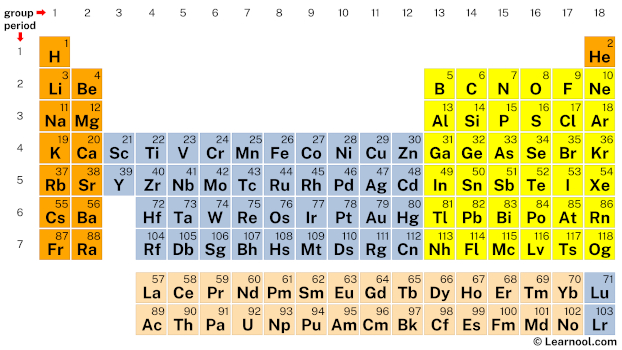
PF4– has one phosphorus atom and four fluorine atoms.
In the Lewis structure of PF4–, there are four single bonds around the phosphorus atom, with four fluorine atoms attached to it. Each fluorine atom has three lone pairs, and the phosphorus atom has one lone pair.
Also, there is a negative (-1) charge on the phosphorus atom.
Steps
Use these steps to correctly draw the Lewis structure of PF4–:
#1 First draw a rough sketch
#2 Mark lone pairs on the atoms
#3 Calculate and mark formal charges on the atoms, if required
Let’s discuss each step in more detail.
#1 First draw a rough sketch
- First, determine the total number of valence electrons

In the periodic table, phosphorus lies in group 15, and fluorine lies in group 17.
Hence, phosphorus has five valence electrons and fluorine has seven valence electrons.
Since PF4– has one phosphorus atom and four fluorine atoms, so…
Valence electrons of one phosphorus atom = 5 × 1 = 5
Valence electrons of four fluorine atoms = 7 × 4 = 28
Now the PF4– has a negative (-1) charge, so we have to add one more electron.
So the total valence electrons = 5 + 28 + 1 = 34
Learn how to find: Phosphorus valence electrons and Fluorine valence electrons
- Second, find the total electron pairs
We have a total of 34 valence electrons. And when we divide this value by two, we get the value of total electron pairs.
Total electron pairs = total valence electrons ÷ 2
So the total electron pairs = 34 ÷ 2 = 17
- Third, determine the central atom
We have to place the least electronegative atom at the center.
Since phosphorus is less electronegative than fluorine, assume that the central atom is phosphorus.
Therefore, place phosphorus in the center and fluorines on either side.
- And finally, draw the rough sketch

#2 Mark lone pairs on the atoms
Here, we have a total of 17 electron pairs. And four P — F bonds are already marked. So we have to only mark the remaining thirteen electron pairs as lone pairs on the sketch.
Also remember that phosphorus is a period 3 element, so it can keep more than 8 electrons in its last shell. And fluorine is a period 2 element, so it can not keep more than 8 electrons in its last shell.
Always start to mark the lone pairs from outside atoms. Here, the outside atoms are fluorines.
So for each fluorine, there are three lone pairs, and for phosphorus, there is one lone pair.
Mark the lone pairs on the sketch as follows:

#3 Calculate and mark formal charges on the atoms, if required
Use the following formula to calculate the formal charges on atoms:
Formal charge = valence electrons – nonbonding electrons – ½ bonding electrons
For phosphorus atom, formal charge = 5 – 2 – ½ (8) = -1
For each fluorine atom, formal charge = 7 – 6 – ½ (2) = 0
Here, the phosphorus atom has a charge, so mark it on the sketch as follows:

In the above structure, you can see that the central atom (phosphorus) forms an octet. And the outside atoms (fluorines) also form an octet. Hence, the octet rule is satisfied.
Now there is still a negative (-1) charge on the phosphorus atom.
This is not okay, right? Because the structure with a negative charge on the most electronegative atom is the best Lewis structure. And in this case, the most electronegative element is fluorine.
But if we convert a lone pair of the phosphorus atom to make a new P — F bond with the fluorine atom, and calculate the formal charge, then we do not get the formal charges on atoms closer to zero.
And the structure with the formal charges on atoms closer to zero is the best Lewis structure.
Therefore, this structure is the most stable Lewis structure of PF4–.
And since the PF4– has a negative (-1) charge, mention that charge on the Lewis structure by drawing brackets as follows:

FAQs
Does the PF4– ion satisfy the octet rule?
Yes, the PF4– ion satisfies the octet rule for all atoms.
In PF4– ion, phosphorus forms four single covalent bonds with the surrounding fluorine atoms, meaning that the total number of electrons around P is 8. Each fluorine atom has 8 electrons around it, which also satisfies the octet rule.
What is the shape of PF4– ion according to its structure?
The shape of PF4– ion is seesaw-shaped. This is because there are four bonding pairs and one lone pair around the central phosphorus atom in the molecule.
The electron pair geometry of the molecule is trigonal bipyramidal. However, since there is a lone pair present, it causes a change in the molecular geometry, resulting in a seesaw-shaped structure.
Note: The electron pair geometry refers to arrangement of all electron pairs, both bonding and non-bonding, around the central atom in a molecule. On the other hand, molecular geometry refers to arrangement of only the bonding pairs of electrons around the central atom.
How many valence electrons are in PF4– ion?
PF4– valence electrons can be calculated by adding up the valence electrons of each atom in the ion and adding the negative charge of the ion.
Phosphorus has 5 valence electrons, and each of the four fluorine atoms has 7 valence electrons. Since PF4– has a negative (-1) charge, one valence electron should be added.
Therefore, PF4– has a total of 5 + 7(4) + 1 = 34 valence electrons.
Next: PO3– Lewis structure
External links
Deep
Learnool.com was founded by Deep Rana, who is a mechanical engineer by profession and a blogger by passion. He has a good conceptual knowledge on different educational topics and he provides the same on this website. He loves to learn something new everyday and believes that the best utilization of free time is developing a new skill.
